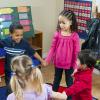- Define social-emotional development and discuss its importance in our lives.
- Reflect on your own ideas and experiences associated with social-emotional development.
- Discuss how social-emotional learning promotes development in young children.
Learn
Know
Think back over the past couple of days. What are some emotions that you felt? Do you recall feeling happy, sad, angry, fearful, or upset in response to receiving news or having a conversation or argument? Now consider how your feelings at the time might have affected some of your social interactions or relationships with others.
Emotions affect who we are and they impact our attention, memory, and learning; our ability to form relationships; and our physical and mental health. They also influence our behaviors, actions, and interactions with others. Think about times you were happy. How did those feelings affect your behavior and, in turn, your interactions? Now, consider times when you were sad, angry, or upset. How did those feelings influence your behaviors and interactions?
Labeling, identifying, and managing emotions are essential skills for meaningful and successful participation in life experiences, both in our professional and personal lives. Emotional intelligence is a term used to describe the ability to understand your own emotions and use them to guide your thinking and actions. Developing emotional intelligence allows you to manage your emotions effectively and avoid frustration and disappointment. Emotions can strongly influence our relationships with others and our overall quality of life.
What is Social-Emotional Development?
Children begin developing social-emotional skills at birth. Research indicates that children are born ready to connect with other people in their environment. When a child’s emotional and physical needs are met, learning pathways to the brain are formed, which lead to learning in all developmental domains. Emotional signals, such as smiling, crying, or demonstrating interest and attention, strongly influence the behaviors of others. Similarly, the emotional reactions of others affect children’s social behaviors. As children mature and develop, their social-emotional skills become less centered on having their own needs met by their caregivers and more focused on participating in routines and enjoying experiences with friends and caregivers.
The early childhood years are a critical time for the formation of positive feelings toward oneself, others, and the larger world. Young children develop and learn in the context of relationships and when they are encouraged, nurtured, and accepted by adults and peers, they are more likely to be well adjusted. On the contrary, children who are neglected, rejected, or abused are at risk for social and mental health challenges.
Supporting the social and emotional health of preschoolers is important because:
- Early relationships set the stage for healthy or unhealthy brain development
- Poor social, emotional, and behavioral development predicts early school failure, which in turn, predicts later school failure
- Early intervention can reduce the need for later, higher-cost interventions
- Supporting children early in life will allow them to give back to society later
Take a moment to think about what social-emotional development means to you. What comes to mind? How do you explain social-emotional development to others? Below, we highlight 5 key competencies of social-emotional development. It is important to recognize that preschoolers are still establishing these abilities. We should not expect preschoolers to have advanced social awareness or decision-making skills, instead know that they are on a path to acquiring these skills, with guidance and support from families and teachers.
According to the Collaborative for Academic, Social, and Emotional Learning (CASEL), social and emotional development (also called social-emotional learning) consists of the following five core components:
Self-awareness:
This is the ability to accurately recognize one’s emotions, thoughts and their influence on behavior. This includes accurately assessing one’s strengths and limitations and possessing a well-grounded sense of confidence and optimism.
We see evidence of this when a preschooler can recognize and identify their own emotions. For example, a preschooler may manage their negative emotions by telling a teacher, “I am sad because I do not want to share my toy from home.” Preschoolers also demonstrate self-awareness when they use props, such as dolls, to identify and express their emotions.
Examples of questions someone who is self-aware may ask:
- What are my thoughts and feelings?
- What causes those thoughts and feelings?
- How can I express my thoughts and feelings respectfully?
Self-management:
This is the ability to control one’s emotions, thoughts, and behaviors effectively in different situations. This includes managing stress, controlling impulses, motivating oneself, and setting and working toward achieving personal and academic goals.
When preschoolers are able to wait their turn, accept reminders about free play ending and clean up, and follow routines with simple reminders, these are examples of self-management.
Examples of questions someone who has good self-management may ask:
- What different responses can I have to an event?
- How can I respond to an event as effectively as possible?
Social awareness:
This is the ability to take the perspective of and empathize with others from different backgrounds and experiences, to understand social norms for behavior, and to recognize family, school and community resources and supports.
A preschooler is developing their social awareness when they express sympathy for a friend who is feeling sad, help another child rebuild their block town when it gets knocked over, or offer to help a peer who is upset after spilling milk. Preschoolers who express concern for the needs of others are demonstrating their social awareness skills.
Examples of questions someone who has good social awareness may ask:
- How can I better understand other people’s thoughts and feelings?
- How can I better understand why people feel and think the way they do?
Relationship skills:
This is the ability to establish and maintain healthy and rewarding relationships with various individuals and groups. This includes clear communication, active listening, cooperation, avoiding social pressure, conflict resolution, and obtaining or providing help when needed.
Preschoolers demonstrate their developing relationship skills by seeking support from a teacher when a peer conflict starts or making suggestions to peers with ways they can work together. Preschoolers also use words rather than actions to express strong feelings (e.g., “I don’t like it when you push.”)
Examples of questions someone who has good relationship skills may ask:
- What actions can I take in to improve my interactions with other people?
- How can I communicate my expectations to others?
- What can I say or do better to understand the expectations others have for me?
Responsible decision-making:
This is the ability to make constructive and respectful choices about personal behavior and social interactions. This includes consideration of ethical standards, safety concerns, social norms, the realistic evaluation of consequences of various actions, and the well-being of self and others.
When a preschooler waits until another child is done playing on a swing and then uses it, offers to share their paint, or holds a bubble wand so a peer can blow bubbles, they are displaying responsible decision-making.
Examples of questions someone who is a responsible decision-maker may ask:
- What consequences will my actions have on myself and others?
- How do my choices align with my values?
- How can I solve problems effectively?
The Role of Family in Social-Emotional Development
Children develop social-emotional skills through their relationships with primary caregivers and within their families. Consider the uniqueness of our society. These different experiences and backgrounds are reflected in the ways families teach children to manage emotions, socialize, and engage with others. For example, in some families, children are taught to avoid eye contact, while in others, eye contact is an essential component of social interaction. These differences also extend to parenting practices and how individuals are taught to manage emotions, including handling stress and coping with adversity.
Family priorities affect social-emotional competence. For example, some families might place a high value on talking about emotions and expressing them as they occur, whereas other families may value doing the opposite. As a preschool teacher, you must be sensitive and respectful of individual differences in social-emotional development when engaging with children in your care and their families.
What Does Social-Emotional Development Look Like in Preschoolers?
During the preschool years, children learn to take turns, share toys and materials, play near each other, talk with peers, and talk about their feelings and the feelings of others. They also begin to follow classroom and home routines independently. Children learn social skills from watching others interact and through conversations with adults and peers. As a preschool teacher, you can play a significant role in promoting children’s social-emotional skills if you engage them early on in meaningful experiences with peers and other adults in your classroom and program.
The following are examples of social-emotional skills preschool children engage in daily:
- Singing along with peers during circle, center, or book time
- Holding hands while walking down the hall during transitions
- Hugging a friend who is sad
- Sharing a snack with a friend, sibling, or caregiver
- Taking turns while building a tower of blocks with a friend
- Passing out silverware to all children while preparing for lunch
- Making statements such as “I made this all by myself!” when accomplishing tasks
- Giving a friend a toy or object that they asked to use
- Telling a teacher they miss their Mom or Dad
- Getting ready for bath time when a parent says it is time to take a bath
- Talking on the phone with a family member who lives far away
- Telling a family member or teacher that they are sad about something
- Roleplaying experiences such as going grocery shopping, visiting the doctor, or family roles
- Waiting in line for a turn at the drinking fountain
- Putting a stuffed animal down for a nap and telling peers to “be quiet, because my pet is taking a nap”
- Completing a difficult puzzle
Social-Emotional Growth and Young Children’s Development
Social-emotional health affects a person’s overall development and capacity to learn. Research suggests that children who have positive social-emotional health tend to be happier, show greater interest in learning, have a more positive attitude toward school, are more likely to participate in classroom activities, and demonstrate higher academic performance than less socially and emotionally competent peers. Therefore, children’s social-emotional health is equally as important as their physical health.
Since social-emotional development affects young children’s growth later in life, social-emotional skills are central to children’s physical well-being, self-expression, learning, and development of relationships. Consider the impact social emotional development has on various areas of development:
- Learning to read involves regulating emotions and activity levels and requires the child to sit and attend to a task
- Learning to walk, swim, run, or ride a bike involves regulating activity level, attending to adult directions, focusing on muscle control, and controlling impulses.
- Learning to communicate involves using socially appropriate strategies for interaction.
- Learning self-help skills involves following directions, controlling emotions to complete challenging tasks, and knowing when and how to ask for help.
- Being successful in school involves understanding classroom expectations and participating in large- and small-group activities with peers.
Success in school is strongly linked to early positive social-emotional development, thus, it is critical to foster social-emotional learning during the early childhood years.
See
Social-Emotional Development: An Introduction
Do
As a preschool teacher, it is your responsibility to provide developmentally appropriate experiences and activities that meet each child’s needs. As you plan and implement your program, you must remember you are setting the foundation for children’s growth and success. When fostering young children’s healthy social-emotional development, consider the following:
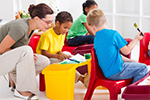 | Plan meaningful, fun experiences for the children in your care while acknowledging their individual differences and backgrounds. |
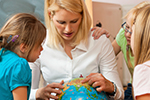 | Embed opportunities for social-emotional learning throughout your school day and provide children with multiple opportunities to express themselves in various ways. |
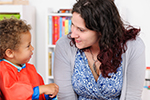 | Acknowledge, validate, and respond to children’s needs, emotions, and concerns. |
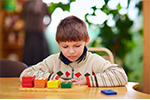 | Be sensitive to children’s unique life circumstances that may influence their social-emotional development. |
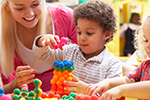 | Arrange your environment in ways that promote children’s social interactions and relationship building with peers and adults in the room. |
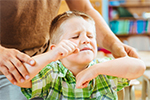 | Use natural classroom events and relationships and interactions with peers and adults as opportunities to talk with children about emotions. |
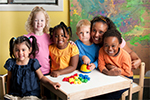 | Acknowledge that, like in any other area of development, individual differences exist in children’s social-emotional development. |
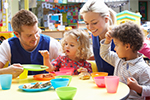 | Reach out to the families of children in your program and learn about their preferred methods of interaction with their children. |
Completing this Course
For more information on what to expect in this course, the Social & Emotional Development Competency Reflection, and a list of the accompanying Learn, Explore and Apply resources and activities offered throughout the lessons, visit the Preschool Social & Emotional Development Course Guide.
Please note the References & Resources section at the end of each lesson outlines reference sources and resources to find additional information on the topics covered. As you complete lessons, you are not expected to review all the online references available. However, you are welcome to explore the resources further if you have interest, or at the request of your trainer, coach, or administrator.
Explore
How do you define social-emotional development? What are your views about your own abilities to build relationships? Download and print the Thinking About Social Emotional Development handout. Take a few minutes to read and respond to the questions. Then, share and discuss your responses with a trainer, coach, or administrator.
Apply
A great deal of research suggests the importance of social-emotional learning for children’s development. Use the Social-Emotional Competence of Children handout, a resource from the Center for the Study of Social Policy to learn more about the importance of social-emotional competence for children’s lives.
Then, re-review the core competence areas from the Social and Emotional Learning Framework developed by The Collaborative for Academic, Social, and Emotional Learning (CASEL). Use the information in the SEL Framework activity to guide your practice as you support preschooler’s social-emotional development.
Glossary
Demonstrate
Berk, L. E. (2013). Child development (9th ed). Pearson.
Bohart, H. & Procopio, R. (2017). Spotlight on young children: Social and emotional development. The National Association for the Education of Young Children.
Brackett, M.A., S.E. Rivers, & P. Salovey. (2011). Emotional intelligence: Implications for personal, social, academic, and workplace success. Social and Personality Psychology Compass 5 (1): 88–103.
Collaborative for Academic, Social, and Emotional Learning (CASEL). (2020). SEL: What are the core competence areas and where are they promoted? https://casel.org/sel-framework/
Denham, S. A., & Brown, C. (2010). “Plays nice with others”: social-emotional learning and academic success. Early Education and Development, 21, 652-680.
Division of Early Childhood of the Council for Exceptional Children. (2014, April 14). DEC recommended practices. https://d4ab05f7-6074-4ec9-998a-232c5d918236.filesusr.com/ugd/95f212_12c3bc4467b5415aa2e76e9fded1ab30.pdf
Funk, S. & Ho, J. (2018). Promoting young children’s social and emotional health. Young Children, 73(1). https://www.naeyc.org/resources/pubs/yc/mar2018/promoting-social-and-emotional-health
National Board for Professional Teaching Standards (2012). Early Childhood Generalist Standards for teachers of ages 3-8 (3rd ed.).
Trawick-Smith, J. W. (2013). Early childhood development: A multicultural perspective (6th ed.). Pearson.


